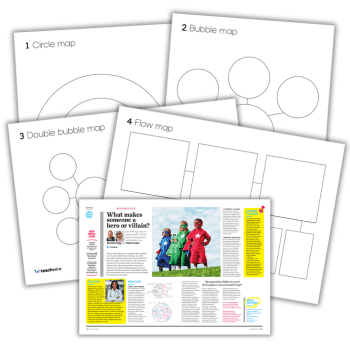It’s Time to Take Risks with your Lessons

Learning should be dangerous, daring and educationally adventurous, and as a teacher you should be making mistakes to learn from along the way, says Ben Cooper…

- by Ben Cooper
- Deputy headteacher and resource creator

Where risks are taken, mistakes are made – and this is where learning happens. This is the philosophy taken by teachers with pupils, but rarely do we have the opportunity to apply it to our own practice.
Observations, performance-based pay and Ofsted inspections often leave teachers reluctant to take risks for fear of making mistakes.
CPD often focuses on improvement and sharing great ideas to support teaching development in the classroom, as opposed to breaking boundaries and evolving teaching and learning.
In fact, more often than not, we’re almost encouraged to play it safe and stick to what we know, particularly during lesson observations.
Isn’t it strange that when we have a chance to gain someone else’s view on our teaching practice, we feel the need to do what we have always done instead of trying something new and getting a second opinion on it?
As the world around us changes so rapidly, it’s time to experiment with your lessons. Be prepared to make mistakes and learn along the way. Be daring and educationally dangerous. Once a week, preferably on a Tuesday, plan a lesson that is a little bit – or very – risky. #TakeaRiskTuesday is all about trying something different in your classroom.
Set yourself a challenge. This is an opportunity to think differently and to approach education and lessons with a different viewpoint. It’s not about getting everything right but more about reflecting on your teaching and how it impacts on learning.
Invite someone in to observe. Ask for their opinion on what they notice. Not on what you are doing as the teacher, but how the risk impacts on the students’ learning.
It’s also really important to gain the students’ opinions. Did they enjoy the change? How did it affect their learning? What did they not like about the new approach?
By taking a risk once a week, you are guaranteeing yourself an opportunity to learn and develop your everyday teaching style and creating a more adventurous culture in your classroom and school.
You are ultimately telling your colleagues and children that mistakes are OK and are in fact the best way to develop. Here are four risky ideas you can take this Tuesday… Use alert symbol with each lesson heading
1 | The question lesson
This challenge is all about effective pupil interactions. We know questions have the power to develop learning, deepen thinking and can encourage independence too. So why not use them all the time?
The challenge is to deliver a whole lesson using only questions. No instructions, no teacher talk – just questions!
Think about how you can deliver instructions by just using questions, or respond to a pupil’s question by asking one in return and prompting them to find the answer for themselves.
If a group of children can’t do it, you can pull them to one side and give them the targeted support they need in a far more personal and effective way.
4 | The silent Lesson
“Too much teacher talk… The lesson was led too much by the teacher.” If you hear these comments as part of your lesson feedback, then this is the challenge for you.
Ronan Keating once sang, “You say it best when you say nothing at all,” and this is sometimes true for teachers too.
So, have a go at teaching without speaking – true facilitation. Gag yourself if you need to.
Think about how activities can be designed and how scaffolds can help a child know what to do next.
Consider how peers can support pupil progress and remember that if one child doesn’t follow your plan, it doesn’t mean they are disobeying you; they may just simply have a better way.
And now reflect…
These challenges are not lesson structures and are not designed to revolutionise teaching.
But while sat in your classroom, gagged and feeling slightly helpless watching your class attempt to lead their own learning, you may discover the one child who is a born leader.
You might also realise that perhaps you have been coddling them a little too much.
And as you try desperately to only use questions to help a confused pupil learn how to complete long division, you might discover that 10-year-old Sarah next to him can explain it in a far better way than you ever could. It is important after you complete each challenge that you reflect on it and the resulting impact on the students’ learning and engagement.
Think about how you can adapt your day-to-day lesson plans based upon what you learnt. Focus on what went well and, perhaps more importantly, what went wrong.
Why not break up the week, mix things up and have fun with these challenges? You could even make it a whole-school initiative. Take a risk together and have a chat about it in the staffroom at the end of the day.
It’s time to realise that for teachers, as with pupils, making mistakes and trying something different is the true way of improving education; our policies and processes might not always encourage this, but it doesn’t make it any less valuable.
After all, if you do what you’ve always done, you’ll get just get the same results. But if you do something different, who knows what will happen?
Ben Cooper is assistant principal at GEMS Wellington Al Khail, a UK curriculum school in Dubai. He is also the creator of LiteracyWAGOLL, a resource website and teaching YouTube channel. Head to literacywagoll.com and follow on Twitter at @literacywagoll.
Perhaps you can use other pupils for support and set your lessons up so no instructions are required. Who knows what will happen? But it will be fun to find out!
2 | The naked lesson
I can imagine you skipped the rest of the article and went straight to this paragraph simply because of the title! No, it doesn’t refer to teaching with no clothes on; it’s about stripping back your lesson to the bare bones.
Jazzy resources are great but sometimes they can distract children from the true focus of the lesson – and they can take an age to make. No lesson needs five different worksheets to support two different groups of learners.
Try delivering a lesson without any teacher-created resources at all.
Think about how pupil-created resources can have an impact on learning. Perhaps they can be created through flipped learning opportunities or even prior lessons.
The vocabulary gathered in a previous literacy lesson is a prefect resource to support writing later in your unit.
This challenge is all about thinking smarter as a teacher. It may even reduce the time it takes to prepare for lessons – win-win!
3 | The inside out lesson
Too often, we stick to similarly structured lessons. They begin with a starter or warm-up followed by teacher input and a main activity.
Forget the old format and try this challenge, which is all about flipping these lesson structures.
Why not try starting the lesson with the main activity and see what happens? Be reactive. Make decisions based on what the children can and can’t do in the activity.
If a group of children can do it already, teacher input will have been pointless anyway. You can challenge them further.
If a group of children can’t do it, you can pull them to one side and give them the targeted support they need in a far more personal and effective way.
4 | The silent Lesson
“Too much teacher talk… The lesson was led too much by the teacher.” If you hear these comments as part of your lesson feedback, then this is the challenge for you.
Ronan Keating once sang, “You say it best when you say nothing at all,” and this is sometimes true for teachers too.
So, have a go at teaching without speaking – true facilitation. Gag yourself if you need to.
Think about how activities can be designed and how scaffolds can help a child know what to do next.
Consider how peers can support pupil progress and remember that if one child doesn’t follow your plan, it doesn’t mean they are disobeying you; they may just simply have a better way.
And now reflect…
These challenges are not lesson structures and are not designed to revolutionise teaching.
But while sat in your classroom, gagged and feeling slightly helpless watching your class attempt to lead their own learning, you may discover the one child who is a born leader.
You might also realise that perhaps you have been coddling them a little too much.
And as you try desperately to only use questions to help a confused pupil learn how to complete long division, you might discover that 10-year-old Sarah next to him can explain it in a far better way than you ever could. It is important after you complete each challenge that you reflect on it and the resulting impact on the students’ learning and engagement.
Think about how you can adapt your day-to-day lesson plans based upon what you learnt. Focus on what went well and, perhaps more importantly, what went wrong.
Why not break up the week, mix things up and have fun with these challenges? You could even make it a whole-school initiative. Take a risk together and have a chat about it in the staffroom at the end of the day.
It’s time to realise that for teachers, as with pupils, making mistakes and trying something different is the true way of improving education; our policies and processes might not always encourage this, but it doesn’t make it any less valuable.
After all, if you do what you’ve always done, you’ll get just get the same results. But if you do something different, who knows what will happen?
Ben Cooper is assistant principal at GEMS Wellington Al Khail, a UK curriculum school in Dubai. He is also the creator of LiteracyWAGOLL, a resource website and teaching YouTube channel. Head to literacywagoll.com and follow on Twitter at @literacywagoll.







